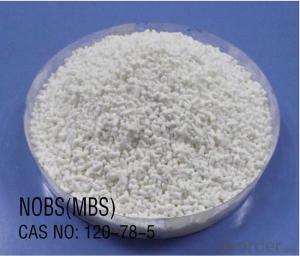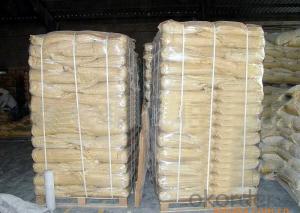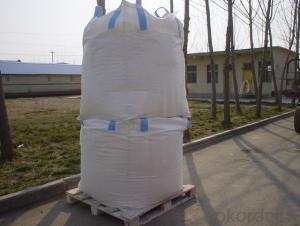Rubber Chemcials Rubber Antioxidant NDBC (NBC)
- Loading Port:
- Tianjin
- Payment Terms:
- TT OR LC
- Min Order Qty:
- 25 m.t.
- Supply Capability:
- 12000 m.t./month
OKorder Service Pledge
OKorder Financial Service
You Might Also Like
NDBC (NBC)
Chemical Name:Nickel Dibutyl Dithiocarbamate
Molecular Formula:C 18 H36 N 2 S 4 Ni
Molecular Weight:467
CAS No.:13927-77-0
Specifications:
Item
| Specifications
|
Appearance
| Dark-green Power (Granules)
|
Initial Melting Point, °C Min.
| 83
|
Heat Loss , % Max.
| 0.5 |
Nickel content , %
| 12.0 - 13.0
|
Residue on 150 µm Sieve , % Max.
| 0.10 |
Residue on 63 µm Sieve , % Max.
| 0.50 |
Properties: Dark-green Power. Density is 1.26g/ cm3 . flashing point is 260°C. Soluble in chloroform, benzene and carbon bisulfide , a little soluble in acetone, insoluble in water.
Applications: Mainly use in styrene- butadience rubber, chloroprene rubber and chlorosul-fonated polyethylene rubber. Avoiding the rubber crack for the sunshine and ozone, promoting the heat-resistant of chloroprene rubber and chlorosul-fonated polyethylene rubber. In plastic industry, it can be used as stabilitant and ozone-resistant agent for high polymer materials. It has advantage of stability for polypropylene fibre , thin film and narrow belt, but it will make the products appear yellow-green color. The use level is 0.3~0.5%. NDBC is regulated for use in articles in contact with food as specified.
Packing:Coextruded paper bags lined with polyethylene film bags. Net weight 25 kg per bag.
Storage:Store closed containers in a cool, dry, well-ventilated area. Avoid exposure to direct sunlight.
- Q:In the presence of catalyst, KCl is produced in the thermal decomposition of KClO3.You did not have a catalyst. Did you get the same products for this reaction as you would have with a catalyst?
- A catalyst changes the RATE of a reaction, not the products. So, yes, you get the same products without the catalyst as you do with the catalyst.
- Q:A biological catalyst or a chemical reaction facilitator is know as a/an?
- A biological catalyst is an enzyme. Here are more details for you. Enzymes – biological catalysts Normally chemical reactions do not proceed spontaneously, but require the help of a catalyst. A catalyst accelerates a chemical reaction without itself being changed. For example, the reaction of hydrogen with oxygen to produce water requires the addition of the metal platinum. These days we encounter the concept of a catalyst most often in connection with technology for cleaning up the exhaust fumes from our automobiles, where platinum and rhodium catalyze the breakdown of polluting nitrogen oxides. Chemical reactions within living cells must also be catalyzed. Biological catalysts are called enzymes. There is, for instance, an enzyme in our saliva which converts starch to a simple sugar, which is used by the cell to produce energy, and another enzyme which degrades the excess lactic acid produced when we overexert ourselves. All green plants contain enzymes which convert carbon dioxide in the air to nutritious carbohydrates such as sugar and starch. Without enzymes life would not be possible! Enzymes are highly selective. Among the thousands of different compounds in a cell, an enzyme can recognize the right molecule (substrate) and transform it into a new product. This property arises from the special three-dimensional structure of each enzyme. One can compare an enzyme and its substrate with a lock and its key. Enzymes are very effective catalysts. A chemical reaction might require several months to reach completion without a catalyst, but only a few seconds with the help of an enzyme. Since the enzyme remains unchanged, one enzyme molecule can catalyze the transformation of millions of substrate molecules. Up until the beginning of the 1980's, all enzymes were thought to be proteins. We now know that proteins do not have a monopoly on biocatalysis. RNA molecules can also function as enzymes.
- Q:Is the catalyst considered a chemical reaction?
- The middle school textbook defines that the catalyst itself does not participate in chemical reactions
- Q:What is the PTC catalyst in chemistry?
- PTC, Phase Transfer Catalyst, phase transfer catalyst PTC is the role of a reaction from one phase to another phase to participate in the reaction to promote a solvent can be dissolved in organic solvents and a solvent insoluble in the ion Reagents react between the two reagents. And this type of reaction is collectively referred to as phase transfer catalytic reaction.
- Q:Co and No form a chemical equation for Co2 and No2 under the action of a catalyst
- Write the catalyst on the horizontal line, where NO is the oxidant and CO is the reducing agent
- Q:and what type of macromolecule are they made of? thanks!
- by definition a catalyst is a substance that alters the cost of, or makes accessible, a chemical or biochemical reaction yet maintains to be unchanged on the tip of the reaction. Enzymes are the only organic biochemical catalysts. Ribozymes are a particular sort of enzymes. certainly, the definition of enzyme rates: organic and organic catalyst produced in cells, and able to dashing up the chemical reactions mandatory for all times. they're great, complicated proteins, frequently soluble, and are noticeably specific, each and every chemical reaction requiring its very own specific enzyme. The enzyme's specificity arises from its energetic website, a community with a shape such as portion of the molecule with which it reacts (the substrate). the form of the enzyme the place the chemical binds in straightforward terms facilitates the binding of that distinctive chemical, such as a particular key in straightforward terms working a particular lock (the lock and key hypothesis). The enzyme and the substrate slot jointly forming an enzyme–substrate complicated that facilitates the reaction to ensue, and then the enzyme falls away unaltered. In prepare maximum catalysts are used to velocity up reactions. There are different non-organic and organic catalysts. maximum of that are utilized in industry and are commonly transition metals or their compounds.
- Q:role of catalyst?
- Catalyst are substances that speed up rate of reactions by providing an alternative route for reaction with a smaller activation energy. (the original route for reaction may have a high activation energy so it will occur slowly). (activation energy= energy of colliding atoms/molecules must be above a certain limit before they can react to form product). catalysts: -- increase speed of reaction, --allow reactions to occur at lower temperature, --are reusable so more environmentally friendly, --for some reactions, form certain intermediate products that maybe commercially important in other productions.
- Q:Chemical Glossary: Catalyst
- The catalyst is a substance that can change the rate of the reaction without changing the standard of the reaction Gibbs free, according to the definition of the International Pure and Applied Chemistry (IUPAC) in 1981, Enthalpy change. This effect is called catalysis. The reaction involving the catalyst is a catalytic reaction.
- Q:The concept of catalyst in high school chemistry
- The catalyst is selective, that is, a catalyst that catalyzes only one or more chemical reactions and does not catalyze all chemical reactions. However, a chemical reaction of the catalyst may be a variety of, such as hydrogen peroxide to produce oxygen in the reaction, in addition to the use of manganese dioxide as a catalyst, you can also use copper oxide, iron oxide as a catalyst. Building on the use of cement, red brick powder also catalyze the decomposition of hydrogen peroxide.
- Q:What are the requirements for the catalyst for the chemical industry?
- Generally find a few, according to the cost and cost of cost, choose cost-effective
1. Manufacturer Overview |
|
|---|---|
| Location | |
| Year Established | |
| Annual Output Value | |
| Main Markets | |
| Company Certifications | |
2. Manufacturer Certificates |
|
|---|---|
| a) Certification Name | |
| Range | |
| Reference | |
| Validity Period | |
3. Manufacturer Capability |
|
|---|---|
| a)Trade Capacity | |
| Nearest Port | |
| Export Percentage | |
| No.of Employees in Trade Department | |
| Language Spoken: | |
| b)Factory Information | |
| Factory Size: | |
| No. of Production Lines | |
| Contract Manufacturing | |
| Product Price Range | |
Send your message to us
Rubber Chemcials Rubber Antioxidant NDBC (NBC)
- Loading Port:
- Tianjin
- Payment Terms:
- TT OR LC
- Min Order Qty:
- 25 m.t.
- Supply Capability:
- 12000 m.t./month
OKorder Service Pledge
OKorder Financial Service
Similar products
New products
Hot products
Related keywords






























